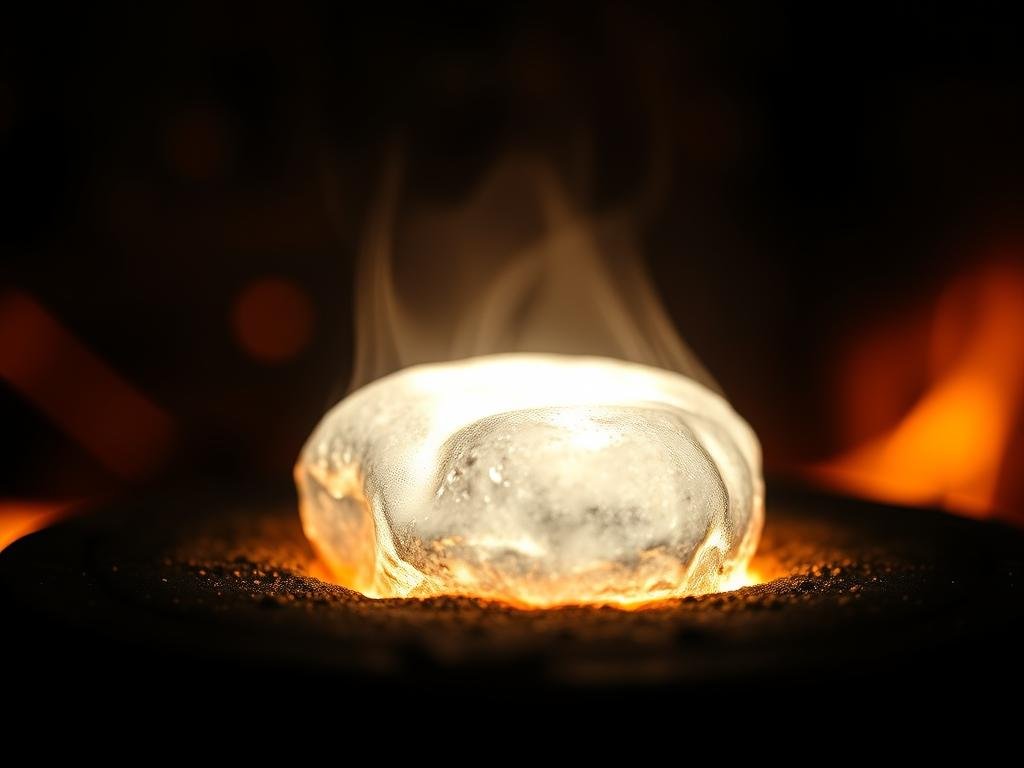Platinum is renowned for its extraordinary properties, particularly its high melting point of 1772°C, making it an ideal material for applications that require extreme temperature resistance.
This precious metal’s exceptional thermal stability allows it to maintain its structural integrity and performance under conditions that would compromise other metals, such as gold.
With its unique atomic structure contributing to strong metallic bonds, platinum is highly resistant to corrosion, a property that has revolutionized numerous industrial applications.
Understanding the significance of platinum’s melting point provides insight into its premium pricing and critical roles in technologies, from automotive to aerospace components.
The Remarkable Properties of Platinum
Platinum’s remarkable attributes are the foundation of its widespread use in demanding applications. Its unique combination of physical and chemical properties makes it an invaluable resource in various industries.
Physical Characteristics and Atomic Structure
Platinum is a dense, malleable metal with a high melting point. Its atomic structure contributes to its stability and resistance to corrosion. As a noble metal, platinum’s low chemical reactivity makes it highly sought after for applications where durability is crucial.
Resistance to Corrosion and Oxidation
Platinum exhibits exceptional resistance to corrosion, surpassing even gold in many environments. It remains unaffected by air and water but will dissolve in hot aqua regia and certain concentrated acids. This resistance to tarnishing and corrosion makes platinum ideal for laboratory equipment, electrical contacts, and medical implants.
Some key benefits of platinum’s resistance include its ability to withstand exposure to most acids and its stability at high temperatures, making it invaluable in industrial processes and catalytic applications.
Understanding Platinum’s Melting Point
Platinum’s melting point is a critical factor in its application across various high-temperature industries. Its exceptionally high melting point of 1772°C makes it an ideal material for environments where other metals would fail.
The Science Behind Platinum’s High Melting Point
The high melting point of platinum is attributed to its strong atomic bonds and dense crystal structure. This results in a metal that is not only resistant to melting but also maintains its strength and integrity under extreme heat. The boiling point of platinum further underscores its thermal stability, reaching an astonishing 3825°C.
Comparison with Other Precious Metals
When compared to other precious metals like gold and silver, platinum’s melting point stands out. Gold melts at 1064°C, and silver at 961°C, making platinum substantially more resistant to thermal deformation. This difference is crucial in applications where metals are exposed to high temperatures.
| Metal | Melting Point (°C) | Boiling Point (°C) |
|---|---|---|
| Platinum | 1772 | 3825 |
| Gold | 1064 | 2856 |
| Silver | 961 | 2162 |
As highlighted by the data, platinum’s rarity and high melting point contribute to its value and specialized use in critical applications, distinguishing it among precious metals.

Historical Challenges of Working with Platinum
The history of working with platinum is marked by significant challenges and groundbreaking discoveries. For a long time, the high melting point of platinum posed a substantial obstacle to its widespread use.
Early Discoveries and Misconceptions
In the late 17th and early 18th centuries, scientists first attempted to melt platinum using sophisticated arrangements of mirrors and lenses to focus intense solar heat. This method, initially used in France, marked the beginning of understanding how to work with this challenging metal.
Breakthrough Methods for Melting Platinum
A critical breakthrough came with the introduction of pure oxygen delivery systems, which could achieve the extreme temperatures needed to reach platinum’s melting point. Wilhelm Heraeus, a German chemist, later developed a reliable oxyhydrogen flame technique capable of consistently melting platinum, establishing the first German platinum smeltery in 1856.
These pioneering methods ended centuries of frustration and opened the door to platinum’s industrial utilization. The development of electric arc furnaces further revolutionized platinum production, providing more controlled and efficient heating methods.
Why Platinum Excels in High-Temperature Applications
Platinum’s exceptional performance in high-temperature applications stems from its unique combination of properties. Its ability to withstand extreme temperatures without losing its integrity makes it an ideal material for various industrial uses.

Thermal Stability and Heat Resistance
One of the key reasons platinum excels in high-temperature environments is its thermal stability. It maintains its structure even when exposed to extreme heat, ensuring consistent performance. As noted by industry experts, “Platinum’s high melting point and resistance to oxidation make it a crucial component in high-temperature applications.”
Catalytic Properties at High Temperatures
Platinum also exhibits excellent catalytic properties at elevated temperatures. This characteristic is particularly valuable in industrial processes where chemical reactions need to be accelerated or controlled. The use of platinum in such applications significantly enhances efficiency and productivity.
Platinum Alloys for Enhanced Performance
To further enhance platinum’s properties, it is often alloyed with other metals like iridium, rhodium, or ruthenium. For instance, adding 5-10% iridium to platinum increases its melting point to approximately 2,454°C and improves its hardness and wear resistance. These platinum alloys are designed to meet specific industrial needs, making them ideal for demanding applications in aerospace, automotive, and laboratory equipment.
According to recent developments, “The aerospace industry relies heavily on platinum alloys for components that must withstand extreme temperatures in jet engines and rocket propulsion systems.” This underscores the metal’s versatility and its critical role in advanced technologies.
Modern Industrial Applications of Platinum
With its remarkable characteristics, platinum plays a crucial role in numerous contemporary industrial processes. Its high melting point, corrosion resistance, and electrical conductivity make it an ideal material for various applications.
Automotive and Transportation Technology
Platinum is used in the automotive industry for electrical contacts and connectors, as well as in strengthening the magnetic fields of computer hard disk drives. The stronger the magnetic field, the more data can be stored. Additionally, platinum’s role in hydrogen fuel cells is pivotal for the growing hydrogen economy, potentially rivaling traditional applications like jewelry and bullion coins.
Laboratory and Medical Equipment
In laboratory settings, platinum is utilized for its ability to withstand extreme temperatures and corrosive environments. It is essential in producing many industrial, agricultural, and household chemicals. Platinum’s catalytic properties also make it valuable in medical equipment and applications.
Electronics and Renewable Energy Systems
The electronics industry benefits from platinum’s exceptional melting point and electrical conductivity in components like specialized resistors and thermistors. Renewable energy systems, particularly hydrogen fuel cells, incorporate platinum electrodes that operate efficiently at high temperatures. Investment products like platinum bullion and coins derive their value partly from the metal’s industrial utility.
Some of the key applications of platinum include its use in glass manufacturing, where it maintains precise dimensional stability at extreme temperatures. Despite its high price, platinum remains the material of choice for products requiring its unique combination of properties.
- The electronics industry utilizes platinum in components that must withstand high operating temperatures.
- Renewable energy systems increasingly incorporate platinum, particularly in hydrogen fuel cells.
- Platinum is essential in producing many industrial, agricultural, and household chemicals.
Conclusion: The Future of Platinum in Advanced Technologies
As industries continue to evolve, platinum’s exceptional properties are poised to play a crucial role in shaping the future of advanced technologies. The demand for platinum is expected to surge, particularly in the hydrogen power industry, with estimates suggesting an eight-fold increase in demand by 2030.
The unique properties of platinum, including its high melting point and resistance to tarnishing, make it an essential material for various industrial applications, from next-generation electronics to aerospace components. As production challenges persist, recycling platinum from catalytic converters and electronic waste will become increasingly important to meet the world’s supply needs.
With its industrial utility expanding into new technological frontiers, platinum’s future appears secure as one of the most technologically important precious metals, extending far beyond traditional uses in jewelry and investment products like platinum bullion and coins.
